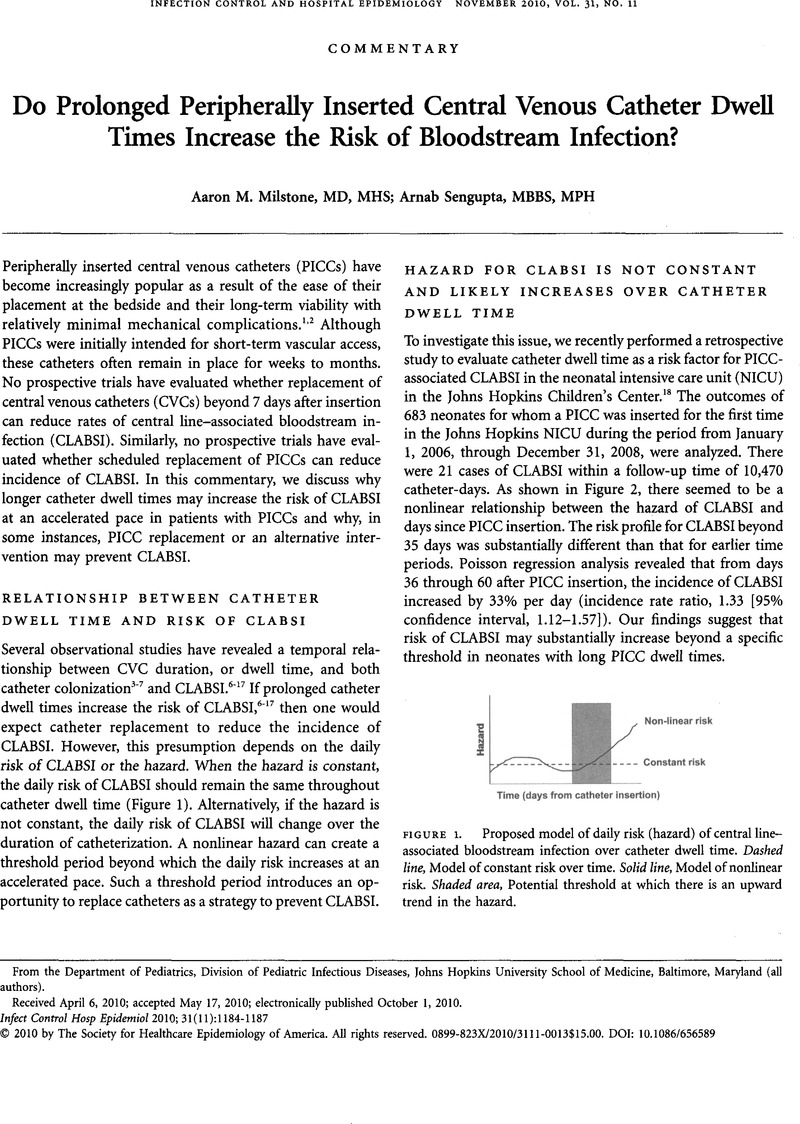Crossref Citations
This article has been cited by the following publications. This list is generated based on data provided by Crossref.
Advani, S.
Reich, N. G.
Sengupta, A.
Gosey, L.
and
Milstone, A. M.
2011.
Central Line-Associated Bloodstream Infection in Hospitalized Children with Peripherally Inserted Central Venous Catheters: Extending Risk Analyses Outside the Intensive Care Unit.
Clinical Infectious Diseases,
Vol. 52,
Issue. 9,
p.
1108.
Chopra, Vineet
Anand, Sarah
Krein, Sarah L.
Chenoweth, Carol
and
Saint, Sanjay
2012.
Bloodstream Infection, Venous Thrombosis, and Peripherally Inserted Central Catheters: Reappraising the Evidence.
The American Journal of Medicine,
Vol. 125,
Issue. 8,
p.
733.
Tejedor, Sheri Chernetsky
Tong, David
Stein, Jason
Payne, Christina
Dressler, Daniel
Xue, Wenqiong
and
Steinberg, James P.
2012.
Temporary Central Venous Catheter Utilization Patterns in a Large Tertiary Care Center Tracking the “Idle Central Venous Catheter”.
Infection Control & Hospital Epidemiology,
Vol. 33,
Issue. 1,
p.
50.
Chittick, Paul
Azhar, Sobia
Movva, Kalyani
Keller, Paula
Boura, Judith A.
and
Band, Jeffrey
2013.
Early Onset versus Late Onset Peripherally Inserted Central Venous Catheter Infections: An Analysis of Risk Factors and Microbiology.
Infection Control & Hospital Epidemiology,
Vol. 34,
Issue. 9,
p.
980.
Milstone, Aaron M.
Reich, Nicholas G.
Advani, Sonali
Yuan, Guoshu
Bryant, Kristina
Coffin, Susan E.
Huskins, W. Charles
Livingston, Robyn
Saiman, Lisa
Smith, P. Brian
and
Song, Xiaoyan
2013.
Catheter Dwell Time and CLABSIs in Neonates With PICCs: A Multicenter Cohort Study.
Pediatrics,
Vol. 132,
Issue. 6,
p.
e1609.
Dumyati, Ghinwa
Concannon, Cathleen
van Wijngaarden, Edwin
Love, Tanzy M.T.
Graman, Paul
Pettis, Ann Marie
Greene, Linda
El-Daher, Nayef
Farnsworth, Donna
Quinlan, Gail
Karr, Gloria
Ward, Lynnette
Knab, Robin
and
Shelly, Mark
2014.
Sustained reduction of central line–associated bloodstream infections outside the intensive care unit with a multimodal intervention focusing on central line maintenance.
American Journal of Infection Control,
Vol. 42,
Issue. 7,
p.
723.
Moureau, Nancy
Sigl, Gordon
and
Hill, Margaret
2015.
How to Establish an Effective Midline Program: A Case Study of 2 Hospitals.
Journal of the Association for Vascular Access,
Vol. 20,
Issue. 3,
p.
179.
Lucet, J.-C.
Chaize, P.
and
Savey, A.
2015.
Le PICC : le chaînon manquant pour l’accès vasculaire.
Journal des Anti-infectieux,
Vol. 17,
Issue. 2,
p.
67.
Beekmann, Susan E.
and
Henderson, David K.
2015.
Mandell, Douglas, and Bennett's Principles and Practice of Infectious Diseases.
p.
3310.
Chopra, Vineet
Flanders, Scott A.
Saint, Sanjay
Woller, Scott C.
O'Grady, Naomi P.
Safdar, Nasia
Trerotola, Scott O.
Saran, Rajiv
Moureau, Nancy
Wiseman, Stephen
Pittiruti, Mauro
Akl, Elie A.
Lee, Agnes Y.
Courey, Anthony
Swaminathan, Lakshmi
LeDonne, Jack
Becker, Carol
Krein, Sarah L.
and
Bernstein, Steven J.
2015.
The Michigan Appropriateness Guide for Intravenous Catheters (MAGIC): Results From a Multispecialty Panel Using the RAND/UCLA Appropriateness Method.
Annals of Internal Medicine,
Vol. 163,
Issue. 6_Supplement,
p.
S1.
Harron, Katie
Mok, Quen
Dwan, Kerry
Ridyard, Colin H
Moitt, Tracy
Millar, Michael
Ramnarayan, Padmanabhan
Tibby, Shane M
Muller-Pebody, Berit
Hughes, Dyfrig A
Gamble, Carrol
and
Gilbert, Ruth E
2016.
CATheter Infections in CHildren (CATCH): a randomised controlled trial and economic evaluation comparing impregnated and standard central venous catheters in children.
Health Technology Assessment,
Vol. 20,
Issue. 18,
p.
1.
Viola, George M.
Rosenblatt, Joel
and
Raad, Issam I.
2017.
Drug eluting antimicrobial vascular catheters: Progress and promise.
Advanced Drug Delivery Reviews,
Vol. 112,
Issue. ,
p.
35.
He, Kui
Wan, Yongxian
and
Xian, Shengping
2018.
Risk analysis on infection caused by peripherally inserted central catheter for bone tumor patients.
Journal of Cancer Research and Therapeutics,
Vol. 14,
Issue. 1,
p.
90.
Voets, Philip J.G.M.
2018.
Central line-associated bloodstream infections and catheter dwell-time: A theoretical foundation for a rule of thumb.
Journal of Theoretical Biology,
Vol. 445,
Issue. ,
p.
31.
Kim, Kwangmin
Kim, Youngkyun
and
Peck, Kyong Ran
2020.
Previous peripherally inserted central catheter (PICC) placement as a risk factor for PICC-associated bloodstream infections.
American Journal of Infection Control,
Vol. 48,
Issue. 10,
p.
1166.
Tian, Luan
Yin, Xinxin
Zhu, Yuxin
Zhang, Xin
Zhang, Congcong
and
Ahmad, Nihal
2021.
Analysis of Factors Causing Skin Damage in the Application of Peripherally Inserted Central Catheter in Cancer Patients.
Journal of Oncology,
Vol. 2021,
Issue. ,
p.
1.
Bahoush, Gholamreza
Salajegheh, Pourya
Anari, Ali Manafi
Eshghi, Alireza
and
Aski, Behzad Haghighi
2021.
A review of peripherally inserted central catheters and various types of vascular access in very small children and pediatric patients and their potential complications.
Journal of Medicine and Life,
Vol. 14,
Issue. 3,
p.
298.
Tripathi, Sandeep
and
Gladfelter, Taylor R.
2021.
Prevalence and Factors Associated With Indwelling Non-Utilized (Idle) Central Vascular Access Devices Across All Age Groups.
Journal of Infusion Nursing,
Vol. 44,
Issue. 5,
p.
282.
Jeong, Jiyoon
Kwun, Yoojin
Kim, Min-ju
Choi, Sang-Ho
Jung, Euiseok
Lee, Byong Sop
Kim, Ki-Soo
and
Kim, Ellen Ai-Rhan
2021.
Targeting Risk Factors for the Control of Central Line-Associated Bloodstream Infection in the Neonatal Intensive Care Unit: A Single Tertiary Center Experience.
Neonatal Medicine,
Vol. 28,
Issue. 3,
p.
116.
Patel, Jay R.
Vellore Govardhan, Shilpa
and
Anton-Martin, Pilar
2023.
Complications associated with peripherally inserted central catheters in paediatric cardiac patients.
Cardiology in the Young,
Vol. 33,
Issue. 1,
p.
79.



